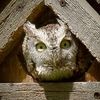Hummingbirds, lenses and settings?
May 19, 2012 18:04:09 #
I sat my new D5100 on the beam next to this feeder and tried to use the remote from inside the house. Sadly, after about 40 seconds the D5100 reverts to single manual release if no shot is taken. So I took this first shot of the feeder just to see how it would work, and it came out nice and sharp. This was with the kit lens, 18-55 3.5-5.6,set at 55mm, 1/200, ISO 100, VR on, sunny but overcast sky.
Since I couldn't use the remote because the birds often didn't return for several minutes, I set up inside the house with the kit 55-300 4.5-5.6 lens at 260mm, 1/4000, ISO 6400, VR off. Notice the noise and lack of clarity in comparison. Is this due to the much higher ISO, or much less shutter duration, or just the quality of the larger zoom?
Thanks in advance for any response,
Bill
Since I couldn't use the remote because the birds often didn't return for several minutes, I set up inside the house with the kit 55-300 4.5-5.6 lens at 260mm, 1/4000, ISO 6400, VR off. Notice the noise and lack of clarity in comparison. Is this due to the much higher ISO, or much less shutter duration, or just the quality of the larger zoom?
Thanks in advance for any response,
Bill
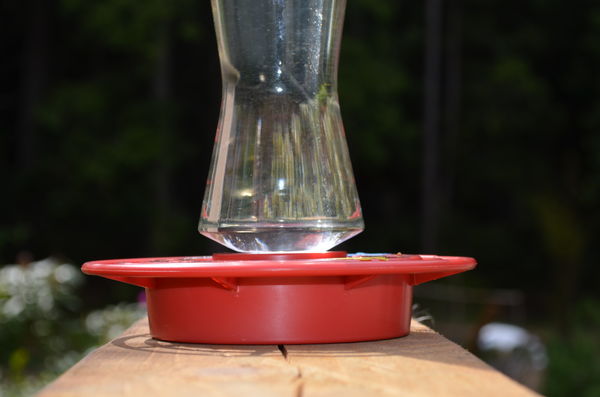
The ever-elusive "Turkey Tailed Hummingbird" right?
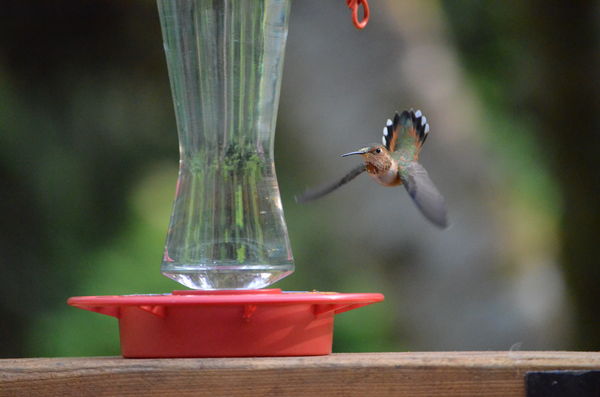
Whoa! AIR BRAKES, AIR BRAKES!
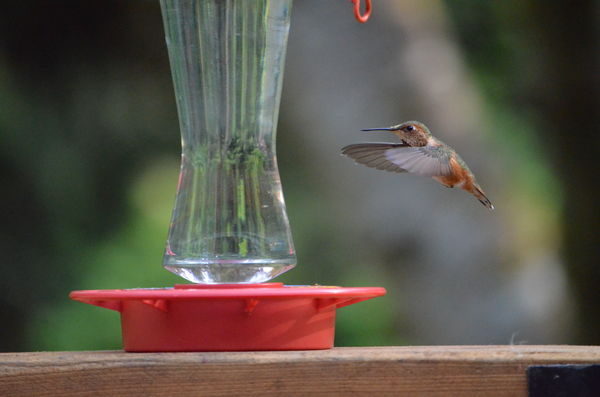
May 19, 2012 23:37:18 #
I think the noise is primarily caused by the very high ISO you were using. To me, it actually looks like your focus was pretty good when enlarging the shots and looking at the eyes. Try dropping the ISO until the shutter speed is around 1/250 second or so and see if that helps. It also helps a lot if you don't shoot through a window. I had exactly the same problem trying to shoot with an electronic remote. The camera goes to sleep after a short time and there you sit until you go to the camera and reactivate it. Are you mechanically inclined? There is a relatively inexpensive solution.
May 20, 2012 01:00:15 #
MJL, what's the solution? Also, the window was opened. Focus was auto.
Thanks.[
quote=MJL]I think the noise is primarily caused by the very high ISO you were using. To me, it actually looks like your focus was pretty good when enlarging the shots and looking at the eyes. Try dropping the ISO until the shutter speed is around 1/250 second or so and see if that helps. It also helps a lot if you don't shoot through a window. I had exactly the same problem trying to shoot with an electronic remote. The camera goes to sleep after a short time and there you sit until you go to the camera and reactivate it. Are you mechanically inclined? There is a relatively inexpensive solution.[/quote]
Thanks.[
quote=MJL]I think the noise is primarily caused by the very high ISO you were using. To me, it actually looks like your focus was pretty good when enlarging the shots and looking at the eyes. Try dropping the ISO until the shutter speed is around 1/250 second or so and see if that helps. It also helps a lot if you don't shoot through a window. I had exactly the same problem trying to shoot with an electronic remote. The camera goes to sleep after a short time and there you sit until you go to the camera and reactivate it. Are you mechanically inclined? There is a relatively inexpensive solution.[/quote]
May 20, 2012 08:12:18 #
You should be able to set the length of time the camera stays on in one of the menus. I set mine to 1 minute but can make it longer if needed. Check the manual.
May 20, 2012 09:13:35 #
Go to your menu-wrench-remote on duration. I can set my D3000 to 15 min. If nothing happens in say 14 min just shoot a picture and you have another 15 min.
May 20, 2012 10:19:37 #
You can set the timer so the camera does not go to sleep as fast. Another problem that I noticed doing this, is that on my camera anyway, there are two red lights that keep flashing. One on the front of the camera and one in the back. The flashing lights seemed to be a distraction to the hummingbirds. So I used some metal from a plant hanger and fashioned a bracket to hold an old bulb and hose shutter actuator from the film camera days. The plunger at the end just makes contact with the shutter button when I squeeze the bulb. Squeeze the bulb half-way and the camera comes back to life, squeeze harder and take pictures. I can set up the camera and sit about 15' away, relax and fire away. Here is a photo of my homemade, cheapo, but effective rig. I hope this gives you some ideas.
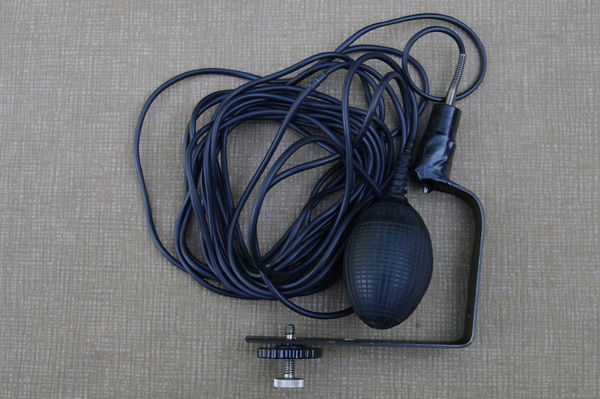
May 20, 2012 12:42:08 #
Gary and Mama, thanks for the reply. The manual only mentions that the remote will revert to manual if no shot within about one minute, but doesn't suggest any adjustment. But you're right, going to menu icon pencil, I can set it for a 15 min max duration, so I'll try that.
MJL, I like your simple low-tech solution. I may try that also. I think the 18-55 set closer will produce much better results.
Cheers!
MJL, I like your simple low-tech solution. I may try that also. I think the 18-55 set closer will produce much better results.
Cheers!
May 20, 2012 13:39:09 #
serrota65 wrote:
[/quote]MJL, what's the solution? Also, the window was opened. Focus was auto.
Thanks.[
quote=MJL] Try dropping the ISO until the shutter speed is around 1/250 second or so and see if that helps.
Thanks.[
quote=MJL] Try dropping the ISO until the shutter speed is around 1/250 second or so and see if that helps.
Forewarned - you will probably lose the wings at that shutter speed though.
May 20, 2012 13:53:34 #
Thanks, I know, that's why I'm trying to stick with 1/4000. While trhe body is usually colorful and interesting, the wings tell the story unseen with the naked eye.
Forewarned - you will probably lose the wings at that shutter speed though.[/quote]
Bozsik wrote:
serrota65 wrote:
MJL, what's the solution? Also, the window was opened. Focus was auto.
Thanks.[
quote=MJL] Try dropping the ISO until the shutter speed is around 1/250 second or so and see if that helps.
Thanks.[
quote=MJL] Try dropping the ISO until the shutter speed is around 1/250 second or so and see if that helps.
Forewarned - you will probably lose the wings at that shutter speed though.[/quote]
May 21, 2012 11:28:44 #
I've used flash to stop the motion very effectively. The hummingbirds get skiddish and leave, but come right back. My issue is getting the auto focus to work when I'm firing remotely. Hundreds of shots to get one or two that are just acceptable. I love hummingbirds, but they are making me lose my hair.
May 21, 2012 11:32:35 #
bkyser wrote:
I've used flash to stop the motion very effectively. The hummingbirds get skiddish and leave, but come right back. My issue is getting the auto focus to work when I'm firing remotely. Hundreds of shots to get one or two that are just acceptable. I love hummingbirds, but they are making me lose my hair.
From my experience, and it is limited, you might want to invest in a wig. :mrgreen:
May 21, 2012 11:48:39 #
OK, I'll try with a flash next time. Meanwhile, here's my lastest, which I think is an improvement, including what I believe is a Grosbeak, through a closed window. Please post your hummers here if you like.
bkyser wrote:
I've used flash to stop the motion very effectively. The hummingbirds get skiddish and leave, but come right back. My issue is getting the auto focus to work when I'm firing remotely. Hundreds of shots to get one or two that are just acceptable. I love hummingbirds, but they are making me lose my hair.
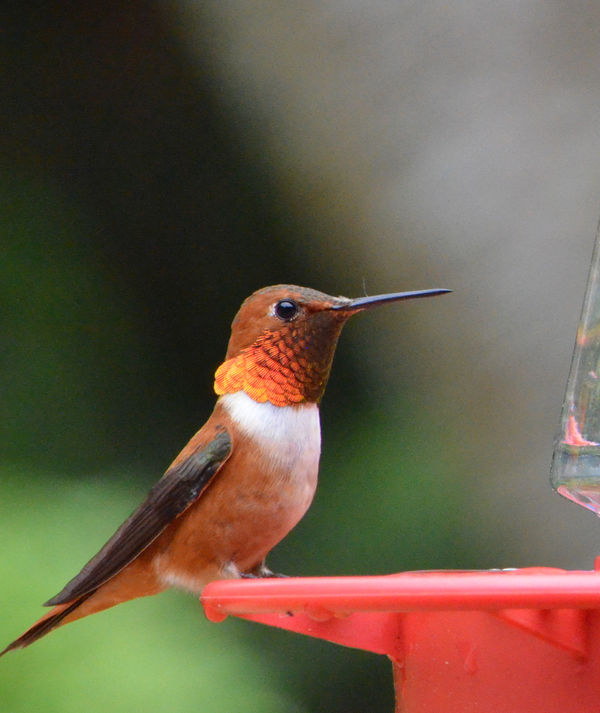
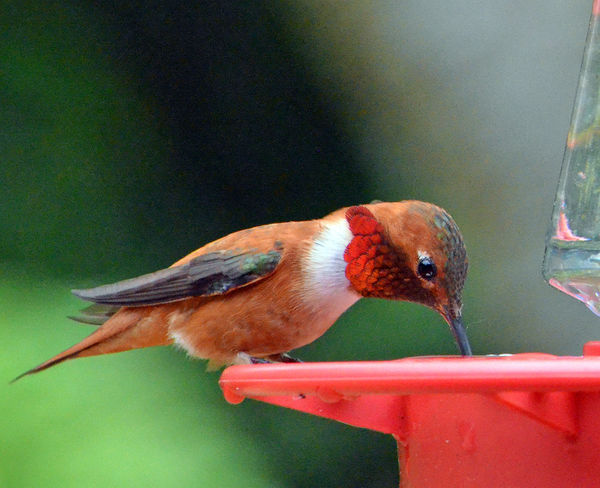
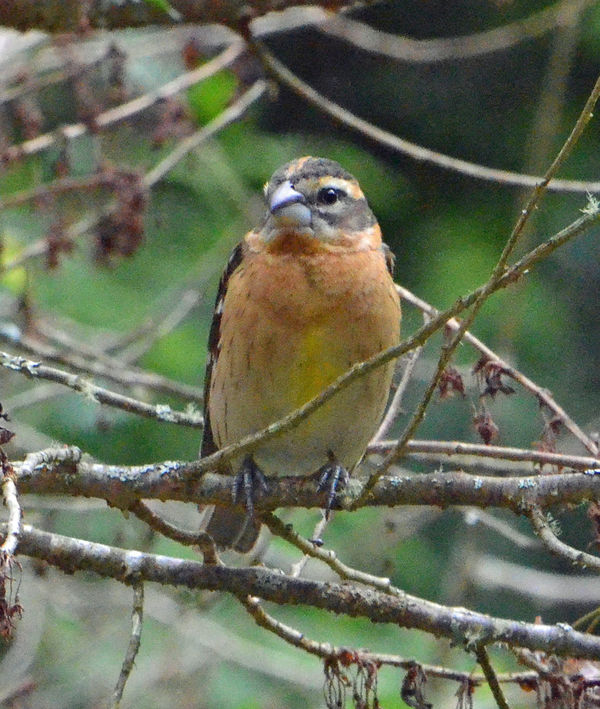
May 21, 2012 11:56:49 #
May 21, 2012 12:32:10 #
glojo
Loc: South Devon, England
I love looking at bird pictures and it is nice to see others getting nice results when shooting through glass.
May 21, 2012 14:59:14 #
Here are a few tips on photographing Hummingbirds:
1. You will need a shutter speed of at least 1/2000 sec to shoot hummers. This will not always stop the wings but a little wing blur is OK.
2. You do not need tremendous depth of field if your camera focuses fast enough. You do not need to shoot wide open but f/5.6 to 8.0 is plenty. Shoot at whatever ISO is needed to get these settings. In bright sun you will be around 400-800
3. Have your camera set to tracking focus. On Canon cameras that is AI Servo-AF. I dont know Nikon or Sony or Olympus.
4. Hummingbirds will get used to having humans around. You can get them acclimated by standing or sitting quietly nearby but far enough away for them to be comfortable. Over the course of days you can gradually get closer and closer.
5. Place the feeder in a location that gets full sun, if possible. If the feeder has multiple feeding ports then use a piece of tape to cover the ones on the back side so they have to come to the front or side to feed. Use a feeder without perches or you will never get flight shots. They dont need them and dont have them when they are feeding at flowers anyway. If you have more than one feeder, take them all down but their most popular one.
6. Set up a chair or stool with your camera on a tripod. You can cover yourself with a light blanket or sheet to hide your human outline. In fact, if you can leave the chair with the sheet and the tripod out for a few days the Hummers will get used to it and wont notice when you are in it.
7. When Hummers feed, they come into a flower or feeder and pause 6-12 inches away from the flower. They feed for a few seconds and back off to hover for a few seconds before going in to sip some more nectar, repeating this several times before flying off. It is when they are in this hover mode that they are most easily photographed in flight. You have to be quick, though, because they will not be there for more than a few seconds. Have your lens pre focused at about that distance so auto focus does not need to hunt before locking on. Use continuous shooting mode and take lots of frames theyre cheap enough. Use a single point for auto focus. When the bird comes in to feed, place the focus point on the birds head, half press the shutter button to initiate Auto Focus and then gently fire away!
8. Hummers will return to a feeder every 15 to 45 minutes during the day. They need to feed very frequently. In between visits to your feeder they are probably making the rounds to all the neighborhood feeders. If they have young in a nest nearby they will come even more frequently. Be patient. The pace also picks up near the end of the day.
9. Hummers often perch on a nearby twig in the open after feeding. They may stay there for 5-10 minutes while they digest your meal. If you can find the perch, you can get some great shots of them in a more natural setting rather than on the feeder.
10. Above all, have patience and respect the birds by not pressuring them too much and scaring them away. Get as close as you reasonably can to get a respectable amount of the frame filled. You dont need to completely fill the frame as that makes it more difficult to find the bird with a long lens. Since you are shooting at relatively high ISOs, this helps keep image noise at a minimum.
11. Flash photography is a whole other animal that would require high speed synch mode. If anyone want some info on it get in touch with me.
That is a Black-headed Grosbeak
1. You will need a shutter speed of at least 1/2000 sec to shoot hummers. This will not always stop the wings but a little wing blur is OK.
2. You do not need tremendous depth of field if your camera focuses fast enough. You do not need to shoot wide open but f/5.6 to 8.0 is plenty. Shoot at whatever ISO is needed to get these settings. In bright sun you will be around 400-800
3. Have your camera set to tracking focus. On Canon cameras that is AI Servo-AF. I dont know Nikon or Sony or Olympus.
4. Hummingbirds will get used to having humans around. You can get them acclimated by standing or sitting quietly nearby but far enough away for them to be comfortable. Over the course of days you can gradually get closer and closer.
5. Place the feeder in a location that gets full sun, if possible. If the feeder has multiple feeding ports then use a piece of tape to cover the ones on the back side so they have to come to the front or side to feed. Use a feeder without perches or you will never get flight shots. They dont need them and dont have them when they are feeding at flowers anyway. If you have more than one feeder, take them all down but their most popular one.
6. Set up a chair or stool with your camera on a tripod. You can cover yourself with a light blanket or sheet to hide your human outline. In fact, if you can leave the chair with the sheet and the tripod out for a few days the Hummers will get used to it and wont notice when you are in it.
7. When Hummers feed, they come into a flower or feeder and pause 6-12 inches away from the flower. They feed for a few seconds and back off to hover for a few seconds before going in to sip some more nectar, repeating this several times before flying off. It is when they are in this hover mode that they are most easily photographed in flight. You have to be quick, though, because they will not be there for more than a few seconds. Have your lens pre focused at about that distance so auto focus does not need to hunt before locking on. Use continuous shooting mode and take lots of frames theyre cheap enough. Use a single point for auto focus. When the bird comes in to feed, place the focus point on the birds head, half press the shutter button to initiate Auto Focus and then gently fire away!
8. Hummers will return to a feeder every 15 to 45 minutes during the day. They need to feed very frequently. In between visits to your feeder they are probably making the rounds to all the neighborhood feeders. If they have young in a nest nearby they will come even more frequently. Be patient. The pace also picks up near the end of the day.
9. Hummers often perch on a nearby twig in the open after feeding. They may stay there for 5-10 minutes while they digest your meal. If you can find the perch, you can get some great shots of them in a more natural setting rather than on the feeder.
10. Above all, have patience and respect the birds by not pressuring them too much and scaring them away. Get as close as you reasonably can to get a respectable amount of the frame filled. You dont need to completely fill the frame as that makes it more difficult to find the bird with a long lens. Since you are shooting at relatively high ISOs, this helps keep image noise at a minimum.
11. Flash photography is a whole other animal that would require high speed synch mode. If anyone want some info on it get in touch with me.
That is a Black-headed Grosbeak
Ruby-throated Hummer, f/8, 1/2000 ISO 3200, Canon 500mm f/4
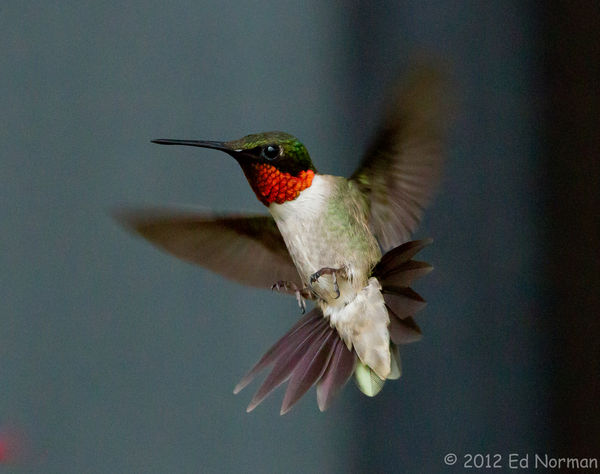
If you want to reply, then register here. Registration is free and your account is created instantly, so you can post right away.






